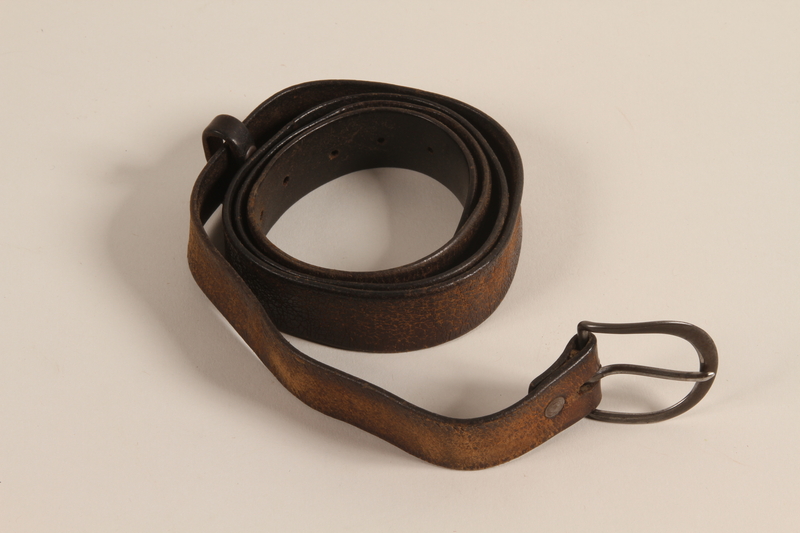Overview
- Brief Narrative
- Leather belt worn by 22 year old Hirsch Birman following his escape from Kedhanen labor camp in 1944. Hirsch was living in Kovno, (Kaunas) Lithuania, with his father Abel, when Germany occupied the city on June 22, 1941. On August 15, they were forced into a sealed ghetto. Hirsch was sent to labor camp Kedahnen in September 1942, and Abel arrived in spring 1943. During the camp's evacuation on July 9, 1944, due to approaching Russian forces, they escaped through holes that Hirsch cut with pliers in the barbed wire fences. They hid in the forest until local farmers told them it was safe to come out. They returned to Kovno, but conditions were very bad and they decided to leave. The war ended on May 7, 1945, and they were in Vienna, Austria, by September. From 1945-1948, Hirsch worked for Bricha (Berihah), a group that organized the illegal immigration of Jews to Palestine, registering refugees at the Rothschild Hospital for displaced persons. He and Abel emigrated to the United States in 1952.
- Date
-
use:
1945 July-1948 May
- Geography
-
use:
Rothschild Hospital;
Vienna (Austria)
- Credit Line
- United States Holocaust Memorial Museum Collection, Gift of Pola Birman
- Contributor
-
Subject:
Pola Schell-Birman
Subject: George Birman
- Biography
-
Pola Szajdenfisz was born on July 13, 1923, in Bendzin (Bedzin), Poland, to Raphael, a businessman, and Gustava. She had 3 sisters: Bala, Sala, and Hanka. The family attended synagogue and kept a kosher house. Though many Poles harbored antisemitic feelings towards Jews, Pola did not experience any problems as she lived in a closeknit Jewish neighborhood.
Germany invaded Poland on September 1, 1939. Raphael believed that because Bendzin was on the German-Polish border, it would be heavily involved in the war. He sent the girls to their paternal grandparents in Lublin, in central Poland. However, the bombing started closer to Lublin. The girls and their grandparents fled on foot. They arrived at a village and spent the night with peasants whom they paid with salt. After a while, they returned to Lublin to find their home destroyed. Their uncle’s house was intact, but another family was living there. They allowed the grandparents, the girls, and the uncle’s family to live in 2 rooms. Gustava had not heard any news from her daughters and went to Lublin. She hired a horse and cart to take them back to Bendzin. When night fell, the driver refused to continue and left them at a farm house; Gustava paid the owners and they alowed them to stay overnight. The next morning, they made their way to the train station and returned home. The biggest change for Pola was that her school had closed. The teachers secretly taught students in private homes until their activities were denounced and put to an end.
By 1942, all Jews were required to wear a Star of David armband, streets were closed off, and German soldiers came to their apartment and took whatever they wanted. The family was evacuated to an open ghetto outside the city where they shared an apartment. The other family lived in the kitchen and Pola’s family in the bedroom. They bought a stove and a curtain divided the room into eating and sleeping areas. The family received orders to go to a meeting place; they were separated except for Pola and Hanka. All were released except Gustava. Pola later found out that this was a selection for a transport to concentration camp Auschwitz. Her mother managed to escape and returned home two days later.
In 1943, Pola went to work at a furniture factory in a suburb of Bendzin, sharpening machine blades. In February, she was arrested, but her family paid a bribe and got her released. Raphael and Hanka were arrested next; Raphael was detained and Hanka was deported to Auschwitz. In February, Pola was arrested again and brought to the holding center where her father was jailed. Raphael returned home and Pola was sent to Graben, a women’s labor camp. She worked in a linen factory separating flax seeds from the fiber. She spoke German and was appointed supervisor. The women worked 12 hour shifts, slept in single beds, had their own bedding they brought form home, and wore their own clothes.; hygiene was maintained at a moderately high level. They worked with Czech laborers who returned home each week and mailed letters for the other prisoners.
In February 1944, Pola and the other prisoners were evacuated on a forced march. They were allowed to take a spoon and bowl, which they tied around their waists with string. The first night they slept in a barn with cows that the girls milked for something to drink. The next day they marched to a railroad station and boarded open cattle cars. They traveled for a day and stopped at a station near a lake and bathed. Locals brought soup to the station for the prisoners. They got back on the train and arrived the next evening at concentration camp Bergen Belsen, Germany. They showered, put on uniforms, and were taken to their barracks and slept on the floor. Pola worked transplanting heather plants for 8-12 hours a day. She was transferred to another barrack and shared a bed with 4 other girls. She contracted typhoid and was bedridden.
The British army liberated the camp on April 15, 1945. Pola and other prisoners were evacuated to a military barrack in Belsen. They arrived naked and cut up army blankets and sewed them into clothes. British authorities offered Pola the chance to emigrate to Sweden and she arrived in Uddevalla on July 5, 1945. She was quarantined in a school turned hospital and given toiletries, 1 Swedish krona, a hospital gown, robe, and slippers. A teacher provided daily Swedish lessons. The refugees were brought food and hid unfinished portions under their pillows. When new food was served, they ate the old and hid the new. After the quarantine was over, Pola was given clothes and sent to a temporary hospital in Karlstad to finish her recovery.
After her release, Paula attended the Swedish Red Cross School of Nursing with money lent to her by the Jewish community. She became a Swedish citizen and served at a Swedish hospital in South Korea during the Korean War. In 1958, she went to the United States as an exchange student in Pittsburgh, Pennsylvania. She moved to New York City and worked in various hospitals. She became a citizen on February 24, 1969. She found a cousin living in Brooklyn who survived Auschwitz and confirmed to Pola that her parents and sisters were murdered in the camp. Mutual friends introduced Pola to her husband George, a Lithuanian Holocaust survivor. She retired from nursing in 1991. George, 87, passed away in 2009.
Hirsch Birman was born on May 31, 1922, in Konigsberg, East Prussia (Kaliningrad, Russia)), to Abel and Zlata. Abel, a lumber merchant, was born on October 2, 1887, in Kovno (Kaunas) Lithuania. When Hirsch was 6 years old, the family moved to Klaipeda, Lithuania. In the early 1930s, Zlata fell ill. She and Hirsch moved in with his maternal grandparents and aunts in the Gargzdai shtetl. Hirsch went to a Jewish grammar school, attended synagogue, and ate kosher. Abel stayed in Kovno and Hirsch visited him during school vacations. When he was 10, Abel gave him a camera and Hirsch photographed friends, family, and daily shtetl life. In 1933, there was a strong and well supported Nazi presence in Klaipeda, a former German territory, Memel, given to Lithuania after WWI, but Hirsch did not experience antisemitic behavior. Zlata died in 1939. Hirsch remained in the shtetl and was raised by an aunt. In 1939, he returned to Kovno.
Germany annexed Klaipeda on March 23, 1939. On June 15, 1940, the Soviets occupied Lithuania and annexed the city in August. They outlawed Hebrew, closed Jewish schools, and suppressed the Jewish culture. On June 22, 1941, Germany invaded the Soviet Union and occupied Lithuania. Many Jews fled Kovno, including Abel and Hirsch. German soldiers apprehended them and forced their return to Kovno. In June and July, there were violent pogroms against Jews, and German Einsatzgruppen [mobile killing units] and Lithuanian auxiliaries massaced thousands.
Abel and Hirsch were forced into the Kovno ghetto which was sealed on August 15, 1941. They lived in a single story wooden building with another family, with a wood stove and without water or indoor plumbing. On September 19, Hirsch was assigned to work the night shift digging up the Kovnos airfield. They moved several times and at one point lived with Hirsch’s paternal uncle and cousins.
In September 1942, Hirsch volunteered to go to Kedahnen labor camp in Lithuania. He shoveled gravel into railroad cars and was responsible for calculating the amount needed to fill each car. As a hobby, Hirsch built crystal radios; he brought one with him and hid it in his barracks. Camp life was bearable; prisoners were permitted to leave and barter with the local peasants, relax after work, and return to the ghetto to visit family. Hirsch even had a girlfriend, Margot, a fellow prisoner and camp cook.
Between May and June, 1943, the Germans transferred 300 prisoners, including Abel, from the Kovno ghetto to Kedahnen to build an airfield and barracks. Hirsch became the chief electrician and installed lighting and wiring. In the spring of 1944, all but 47 prisoners were sent to work at another airport; Abel and Hirsch remained. By June, Hirsch could hear the Soviet army approaching, and fearing evacuation, decided to escape. He had managed to keep over 150 photos with him throughout his imprisonment. On July 9, he gave them and other documents to Abel, who worked as a cook, and Abel wrapped them in wax paper and buried them under the kitchen. Hirsch then hung a blanket on the barbed wire fence and used electrical pliers to cut the fence in 3 places. The next day, the Germans told the prisoners they were being evacuated to the Kovno ghetto. The transport came and while the guard talked to the truck driver, Hirsch, Abel, and another man approached the fence. The blanket shielded Hirsch from view; he bent the fence, cut through the second fence, and they escaped. They crawled along a ditch and hid in a field. The camp guards realized they had escaped, but did not pursue. Hirsch located the peasants he bartered with and they provided the men with food and shelter. As the Russians approached, they hid in the forest and dug a trench for protection. The peasants let them know when the Russians arrived and that it was safe to come out.
In August 1944, Hirsch and Abel returned to the labor camp, dug up the papers and photos, and photographed the abandoned camp. They returned to Kovno and stayed in the apartment of a cousin, Iasha Polunski , who was exiled to Siberia before the war. They had no food and Hirsch stole electricity from military electrical lines. He traded his watch, which he had kept throughout his imprisonment, for food, and went to work cleaning up bomb damaged areas. Hirsch joined a Zionist organization and planned to emigrate illegally to Palestine with Abel. He traveled to Poland with false papers claiming he was Polish and had the right to repatriate. He arrived in Łódź and found his old girlfriend Margot. When the war ended in Europe, on May 8, 1945, Hirsch was at a train station in Warsaw, watching celebratory fireworks.
He and Abel arrived in Vienna, Austria, via Czechoslovakia, in September 1945. They lived at the Rothschild Hospital and worked for Bricha, a group that organized the illegal immigration of Jews from Eastern Europe to Palestine. Hirsch registered the refugees and Abel was a supply manager. In August 1946, Hirsch was the camp leader at Rupertusplatz displaced persons camp for trnasient Jews. He entered the Technology Institute of Vienna and studied engineering. In 1947, he smuggled a group of Jews over the Italian Alps to board illegal ships bound for Palestine. He finished school in 1951, and in anticipation of emigrating to Israel, Abel and Hirsch sent their belongings ahead. In February 1952, the Jewish Institution in Vienna ran out of eligible people to send to the United States. They pressured Hirsch and Abel to change plans and emigrate to America. They settled in New York. Mutual friends introduced George to Pola Schell, a nurse. Pola was born on July 13, 1923, in Bedzin, Poland. She was a survivor of Auschwitz and Bergen Belsen concentration camps. George, 87, passed away in 2009.
Physical Details
- Classification
-
Dress Accessories
- Category
-
Belts (Clothing)
- Object Type
-
Belts (Clothing) (lcsh)
- Physical Description
- Dark brown leather belt with a single prong, silver colored metal D ring buckle attached by a riveted leather fold at one end. The other end has a triangular tip and 2 sets of holes: 1st set has 9 machine made holes; the 2nd has 1 machine made and 6 rectangular hand punched holes. It has a movable leather loop and signs of wear.
- Dimensions
- overall: Height: 43.750 inches (111.125 cm) | Width: 1.625 inches (4.128 cm) | Depth: 0.500 inches (1.27 cm)
- Materials
- overall : leather, metal
Rights & Restrictions
- Conditions on Access
- No restrictions on access
- Conditions on Use
- No restrictions on use
Keywords & Subjects
Administrative Notes
- Legal Status
- Permanent Collection
- Provenance
- The belt was donated to the United States Holocaust Memorial Museum in 2010 by Pola Birman, the widow of George Birman.
- Funding Note
- The cataloging of this artifact has been supported by a grant from the Conference on Jewish Material Claims Against Germany.
- Record last modified:
- 2023-05-26 10:00:28
- This page:
- https://collections.ushmm.org/search/catalog/irn41083
Also in George Birman collection
The collection consists of a belt, hunting knife, pliers, wristwatch, agenda planners, documents, and photographic materials relating to the experiences of George Birman and his father Abel before World War II in Lithuania, during the war when they were interned in Kovno (Kaunas) ghetto and Kedahnen (Kedainiai) labor camp, and after the war as displaced persons, including George's postwar education and work with displaced persons in Vienna, Austria.
Date: 1930-2002
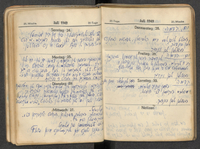
George Birman papers
Document
The George Birman papers consist of an admission ticket to the International Military Tribunal, eight pocket size daily agenda planners, biographical materials, photographic materials, and printed materials documenting George Birman’s childhood in Lithuania, his confinement with his father, Abel Birman, in the Kovno (Kaunas) ghetto, his work at the Kedahnen (Kedainiai) labor camp, and his postwar education and work with displaced persons in Vienna. The admission ticket permitted entrance to the visitor’s gallery of the International Military Tribunal during session 116. Eight pocket size daily agenda planners include daily and weekly notes about George Birman’s postwar activities in Europe from April 1945 through January 1953. Biographical materials include identification papers, citizenship records, certificates, and employment records documenting Abel and George Birman’s wartime and postwar activities in Lithuania and Austria and student and medical records related to George Birman. This series also includes two Polish Red Cross registration certificates for Cwi Egosz, Aba Gachelet, Margo Bartos, Moses Joffe, Chana Tehora, Jofi Lechuchot, Cwi Chotil, Kosrona Lanegen Leli Lanegen, and Techoh Jericho. Photographic materials include four albums, six folders of loose photographs, and a box of negatives. The photo albums contain photographs dating from 1930 through 1950 depicting George Birman, his family, and his friends in prewar Lithuania and postwar Austria, Italy, Lithuania, Germany, Palestine, and France. Loose photographs date from 1931‐1954 and are minimally identified. They depict George and Abel Birman, friends, students, and children in Lithuania, Austria, and France. Photographs include portraits, school rooms, demonstrations, meetings, street scenes, the Rupertusplatz displaced persons camp, and the Gargzdai shtetl. The box of negatives corresponds to photo album 3. Printed materials include clippings, postcards depicting the MS General C.H. Muir, and a commemorative booklet about the Kaunas ghetto.
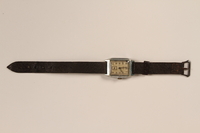
Brown strap wrist watch worn postwar by a former labor camp inmate and aid worker
Object
Dark brown leather wrist watch worn by Hirsch Birman after the war as a refugee in Vienna, Austria. Hirsch and his father Abel lived in Kovno, (Kaunas) Lithuania, which was occupied by Germany on June 22, 1941. They fled, but were caught and brought back. On August 15, they were forced into a sealed ghetto. Hirsch was sent to Kedahnen concentration/labor camp in September, and Abel arrived in spring 1943. When the camp was being evacuated on July 9, 1944, due to approaching Soviet forces, they escaped through holes that Hirsch cut with pliers in the barbed wire fences. They hid in the forest until told by local farmers that it was safe to come out. They returned to Kovno but conditions were very bad and they decided to leave even though they had no permits. The war ended on May 7, 1945, and they arrived in Vienna, Austria, in September. From 1945-1948, Hirsch lived in displaced persons camps and worked for Bricha, a group that organized the illegal immigration of Jews to Palestine. He and Abel emigrated to the United States in 1952.
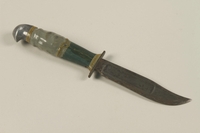
Hunting knife with leather sheath used by Lithuanian labor camp inmate
Object
Survival knife with a leather sheath worn by Hirsch Birman, who called it a Boy Scout knife, following his escape from Kedhanen concentration/labor camp in July 1944. Hirsch and his father Abel lived in Kovno, (Kaunas) Lithuania, which was occupied by Germany on June 22, 1941. They fled, but were caught and brought back. On August 15, they were forced into a sealed ghetto. Hirsch was sent to Kedahnen concentration/labor camp in September, and Abel arrived in spring 1943. When the camp was being evacuated on July 9, 1944, due to approaching Soviet forces, they escaped through holes that Hirsch cut with pliers in the barbed wire fences. They hid in the forest until told by local farmers that it was safe to come out. They returned to Kovno but conditions were very bad and they decided to leave even though they had no permits. The war ended on May 7, 1945, and they arrived in Vienna, Austria, in September. From 1945-1948, Hirsch lived in displaced persons camps and worked for Bricha, a group that organized the illegal immigration of Jews to Palestine. He and Abel emigrated to the United States in 1952.
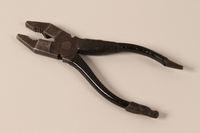
Pliers used by Lithuanian labor camp inmate to escape
Object
Cutting combination pliers used by 22 year old Hirsch Birman to escape the German labor camp, Kedahnen on July 9, 1944. Hirsch was living in Kovno, (Kaunas) Lithuania, with his father Abel, when Germany occupied the city on June 22, 1941. On August 15, they were forced into a sealed ghetto. Hirsch was sent to labor camp Kedahnen in September 1942, and Abel arrived in spring 1943. During the camp's evacuation on July 9, 1944, due to approaching Russian forces, they escaped through holes that Hirsch cut with pliers in the barbed wire fences. They hid in the forest until local farmers told them it was safe to come out. They returned to Kovno, but conditions were very bad and they decided to leave. The war ended on May 7, 1945, and they were in Vienna, Austria, by September. From 1945-1948, Hirsch worked for Bricha (Berihah), a group that organized the illegal immigration of Jews to Palestine, registering refugees at the Rothschild Hospital for displaced persons. He and Abel emigrated to the United States in 1952.

